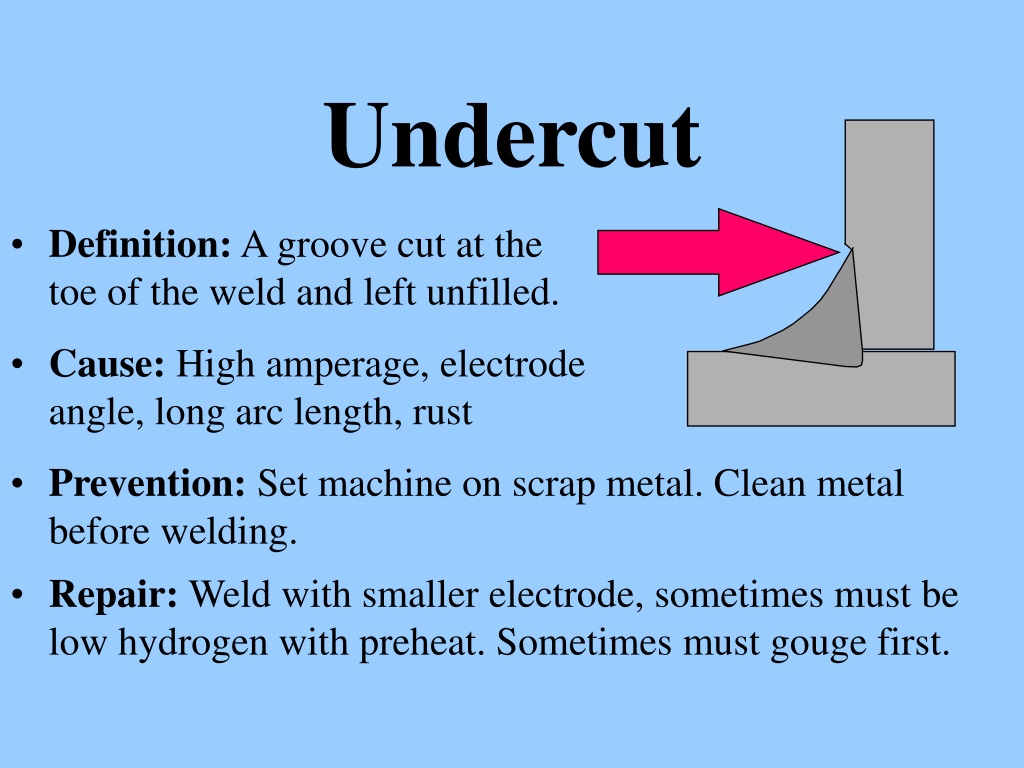Step-by-Step Overview to Preventing Weld Undercut in Different Metals
Step-by-Step Overview to Preventing Weld Undercut in Different Metals
Blog Article
Grasping the Art of Welding: Just How to Prevent Undercut Welding Issues for Flawless Manufacture Results
Performance and accuracy are critical worldwide of welding, where also the tiniest blemish can compromise the structural stability of a fabricated piece. One usual challenge that welders face is undercutting, a problem that can lead and weaken a weld joint to expensive rework. By comprehending the origin of undercut welding and applying reliable techniques to stop it, welders can elevate their craft to brand-new degrees of quality (Preventing weld undercut). In the search of remarkable manufacture outcomes, mastering the art of welding to stay clear of undercut problems is not simply a skill but a requirement for those pursuing excellence in their work.
Comprehending Undercut Welding

To avoid undercut welding, welders ought to make sure correct welding specifications, such as adjusting the existing, voltage, travel rate, and preserving the right electrode angle. By recognizing the causes of undercut welding and applying preventative procedures, welders can attain premium, structurally audio welds.
Root Causes Of Undercut in Welding
Recognizing the elements that contribute to undercut in welding is important for welders to generate high-grade, structurally audio welds. Inadequate welding wrong or present welding speed can also contribute to damage. Comprehending these reasons and implementing appropriate welding methods can assist stop damaging concerns, making certain resilient and solid welds.
Strategies to stop Undercutting

To mitigate the danger of damaging in welding, welders can utilize strategic welding strategies aimed at improving the top quality and stability of the weld joints. Furthermore, making use of the appropriate welding technique for the specific joint configuration, such as weave or stringer grains, can add to minimizing undercutting.
Moreover, proper joint preparation, including making sure clean base products complimentary of contaminants and making use of the appropriate welding consumables, is crucial in stopping undercut defects. Employing back-step welding strategies and managing the weld bead account can also help disperse warm equally and lessen the threat of undercut. Routine inspection of the weld joint during and after welding, in addition to applying quality control steps, can assist in finding and resolving damaging concerns without delay. By executing these strategies carefully, welders can achieve remarkable manufacture results with minimal undercut issues.
Significance of Proper Welding Parameters
Picking and keeping ideal welding specifications is essential for attaining effective welds with marginal defects. Welding parameters describe variables such as voltage, existing, travel speed, electrode angle, and protecting gas circulation price that directly try this affect the welding process. These specifications need to be thoroughly changed based upon the kind of material being welded, its density, and the welding strategy used.
Appropriate welding specifications ensure the correct amount of heat is put on thaw the base steels and filler material consistently. If the parameters are established too expensive, it can result in too much warm input, creating burn-through, spatter, or distortion. On the various other hand, if the specifications are too low, incomplete combination, lack of penetration, or damaging may happen.
Quality Control in Welding Operations

Conclusion
Finally, grasping the art of welding calls for a detailed understanding of undercut welding, its pop over to this web-site causes, and techniques to avoid it. By making certain proper welding criteria and implementing quality guarantee techniques, perfect construction results can be achieved. It is necessary for welders to continually pursue excellence in their welding procedures to avoid undercut problems and generate top notch welds.
Undercut welding, a common problem in welding processes, occurs when the weld steel doesn't correctly fill up the groove and leaves a groove or anxiety along the welded joint.To prevent undercut welding, welders must make sure proper welding specifications, such as changing the current, voltage, traveling rate, and preserving the appropriate electrode angle. Poor welding wrong or current welding rate can also contribute to damage.To mitigate the threat of damaging in welding, welders can use critical welding strategies intended at improving the top quality and integrity of the weld joints.In final thought, understanding the art of welding calls for an extensive understanding of undercut welding, its reasons, and techniques to stop it.
Report this page